AI for Impact: Skilling Up Nonprofit Leaders for the Latest Generative Technology


The artificial intelligence boom is in full swing, as generative AI tools like Jasper and ChatGPT take over our workplaces and AI-based chatbots play feature in everything from the way we shop to the way we learn. Globally, 77 percent of businesses are using or exploring AI, but smaller companies with fewer resources tend to be slower to adopt. The technology giant Salesforce is looking to extend the potential of AI to another group at risk of falling behind.
Nonprofit organizations provide a vital lifeline to underserved people and communities worldwide, but many are understaffed, strapped for budget and could use some help of their own. AI technologies have the potential to automate mundane tasks and support dynamic new tools for the people and communities nonprofits serve. But nonprofit leaders aren't exactly known as technology trailblazers, and lack of resources when it comes to tech means that many miss out on the opportunities emerging technologies can afford.
"When we think about digital transformation and the AI revolution that we're in right now, how the world is undergoing this incredible shift, we want to make sure the organizations that are serving our communities — those on the front lines, working day in and day out — really have the tools they need to do that work," said Naomi Morenzoni, SVP of philanthropy for Salesforce.
Indeed around 74 percent of nonprofits consider digital transformation a “need-to-have” or “must-have,” according to 2022 Salesforce research, but many struggle to move beyond the row of dusty desktop computers donated in decades past.
Salesforce's newest accelerator, AI for Impact, is looking to change that by providing funds, technology and coaching to help nonprofits unlock the potential of AI to further their missions.
"I think of AI, and generative AI in particular, as augmenting the superpowers of nonprofit staff and leaders. It helps them do what they do best in a more efficient or effective way," Morenzoni said. "The AI for Impact Accelerator brings together unrestricted funding, donated technology, as well as one-on-one coaching from Salesforce experts and staff to help them as they're shaping and developing those strategies."
From skills-matching to teacher simulations: Inside the AI for Impact Accelerator
The first round of the AI for Impact Accelerator will distribute $2 million in funding to help six nonprofits develop new solutions using AI.
The organizations vary in their size and approach, but all focus on education and workforce development. The U.S. organization Per Scholas, for example, connects people with the skills and resources they need to switch careers into technology. That takes the form of free technical training, as well as coaching and consultation. It's highly impactful work — with more than 20,000 graduates moving on to successful tech careers — but it often relies on individualized services that can be difficult to scale.
"These are often individuals who've maybe been a cashier at Walmart or a floor manager at Chipotle. They have a lot of skills and experience managing a high volume of customers, doing operations or dealing with complex situations, but it's hard to translate those skills directly to a traditional tech resume," Morenzoni explained.
Per Scholas' career coaches work with learners one-on-one to build resumes and cover letters that clearly connect their skills to what's needed by technology employers. "But that's really time and labor intensive," Morenzoni said.
Through AI for Impact, Per Scholas is looking to automate the first pass of the process with an AI tool that matches each learner's experience with in-demand skills, allowing career coaches to spend more time on the nuanced conversations that can really set learners up for success.
The nonprofit is definitely onto something: Surveys suggest nearly half of all jobseekers now craft their resumes and cover letters with the help of generative AI tools like ChatGPT, so it's easy to see how a custom AI solution could make this crucial step of the job search faster and easier for Per Scholas staff and the people they serve.
Meanwhile, in the U.K., the nonprofit Teacher Development Trust is looking to mirror the success of another industry to help educators do their jobs better. "Flight simulation has transformed the way that pilots fly," Morenzoni explained, and the nonprofit hopes to do the same with teacher simulations.
As a former teacher, Morenzoni knows all about the difficulties that come with managing a classroom and the doubt that can creep in after facing difficult situations. "Being in the classroom can be a really lonely experience, and classroom management is really, really hard," she said. "I used to leave a situation and and think, 'Oh gosh, how could I have handled that differently?' Maybe I'd talk to my department chair, and they would give me some coaching."
The Teacher Development Trust aims to automate this process for the 4,000 educators it serves annually across the U.K. "Their idea is creating an on-demand, chat-based simulation for teachers where they can put in their exact environment, what happened in the classroom, what their mix of students are, and get fed back a real-time simulation — based on the pedagogy we know is trusted from the Teacher Development Trust — to help guide those teachers in the process of responding," Morenzoni said. "Again, it's taking that superpower of one-on-one coaching and making it scalable and making it faster so those teachers can really get the support they need."
Likewise, the U.S. organization College Possible is developing an AI-driven platform to assist coaches as they work to get students from underserved communities into college, while the global organization CareerVillage.org aims to leverage AI to "put the world’s greatest career coach in the pocket of millions of young people."
The organizations will be incubated in a six-month cohort, where they'll receive coaching from Salesforce experts about how to build their solutions effectively and ethically in order to maintain user trust. More than 300 Salesforce employees signed up to provide pro-bono coaching to nonprofit partners. Six will ultimately serve as coaches, with their skills closely matched to each nonprofit's needs.
"One of the things we hear consistently from our nonprofit partners is that the talent gap and being able to access top talent around technology is a real challenge," Morenzoni said. "Being able to connect them with our developers, architects, and data scientists to provide one-on-one coaching and support is invaluable for those organizations."
Coaches will be available for another six months after the cohort wraps, and the nonprofits will have free access to Salesforce products for two years to support the development of their AI solutions.
More work is needed to help nonprofits unlock the power of AI
While it's too early to tell how an accelerator model like this can work for nonprofits, Salesforce is already seeing promising results from its first nonprofit accelerator launched last year. The four nonprofits incubated in Salesforce's Accelerator for Nature are already starting to implement new solutions using technology — including the nonprofit Rainforest Connection's AI acoustic monitoring tool that can pick up the sounds of illegal deforestation.
Results like these demonstrate the untapped potential of AI for nonprofits, but much more work is needed in order to help them realize it. "During this moment of an AI revolution where everyone is moving as fast as possible, we need to make sure that these organizations are not left behind," Morenzoni said.
Salesforce pioneered the 1-1-1 model of philanthropy, donating 1 percent of corporate equity, 1 percent of product and 1 percent of employee time to community causes since its inception. Thousands of companies have signed up to do the same through the 1% Pledge, and Salesforce is looking to get more leaders on board.
"Every company should be stepping up with its technology, its products, its services, and its people to serve our communities," Morenzoni said. "And to do that effectively, they have to start with listening. They have to start with trust, and they have to be led by the organizations who are doing the work day in and day out."
Image credits: terovesalainen/Adobe Stock and Salesforce
We Asked Americans What They Think About the Term “ESG.” Their Answers Were Eye-Opening


The term ESG is fine, according to a recent poll of 1,000 Americans. Despite continued polarization related to the acronym, which stands for environmental, social and governance, the majority of Americans believe it’s the best way to describe a company’s approach to improve business, society and the environment. Before we get to the data, though, it’s important to understand why we asked this question in the first place.
How did we get here?
Over the past year, a rising chorus of conservative U.S. voices have claimed that ESG is “woke capitalism,” or corporate virtue signaling about social and environmental concerns which they see as beyond the bounds of business.
The issue drew President Joe Biden’s first presidential veto in March of this year, defending legislation related to ESG investing and bringing the issue into the national spotlight. ESG is facing such a significant backlash that BlackRock CEO Larry Fink, long one of the financial industry’s staunchest proponents for purpose and ESG, doesn’t even want to use the term — though BlackRock's policies around society, the environment, and business governance remain unchanged.
It’s also important to establish that whatever you call them, sound ESG practices are not new, and are indeed vital to operating a responsible, ethical, and profitable business. As Fortune sustainability reporter Eamon Barrett observed, “major corporations documenting their environmental, social, and governance policies for investor scrutiny is actually a decades-old process.” At its core, ESG is a means to broaden the lens on what constitutes key drivers of business value, accompanied by efforts to measure and report on what matters for individual company operations via standardized reporting frameworks.
Americans say ESG is a-okay
We partnered with Purpose Collaborative member Reputation Leaders, a global research and thought leadership consultancy, to ask Americans what term they feel best describes “the approach companies take to improve business, society and the environment.”
ESG and sustainability are tied for the top, at 23 percent each. Corporate social responsibility is second, at 21 percent, followed by purpose (11 percent), corporate citizenship (8 percent), stakeholder capitalism (7 percent) and stewardship (5 percent).
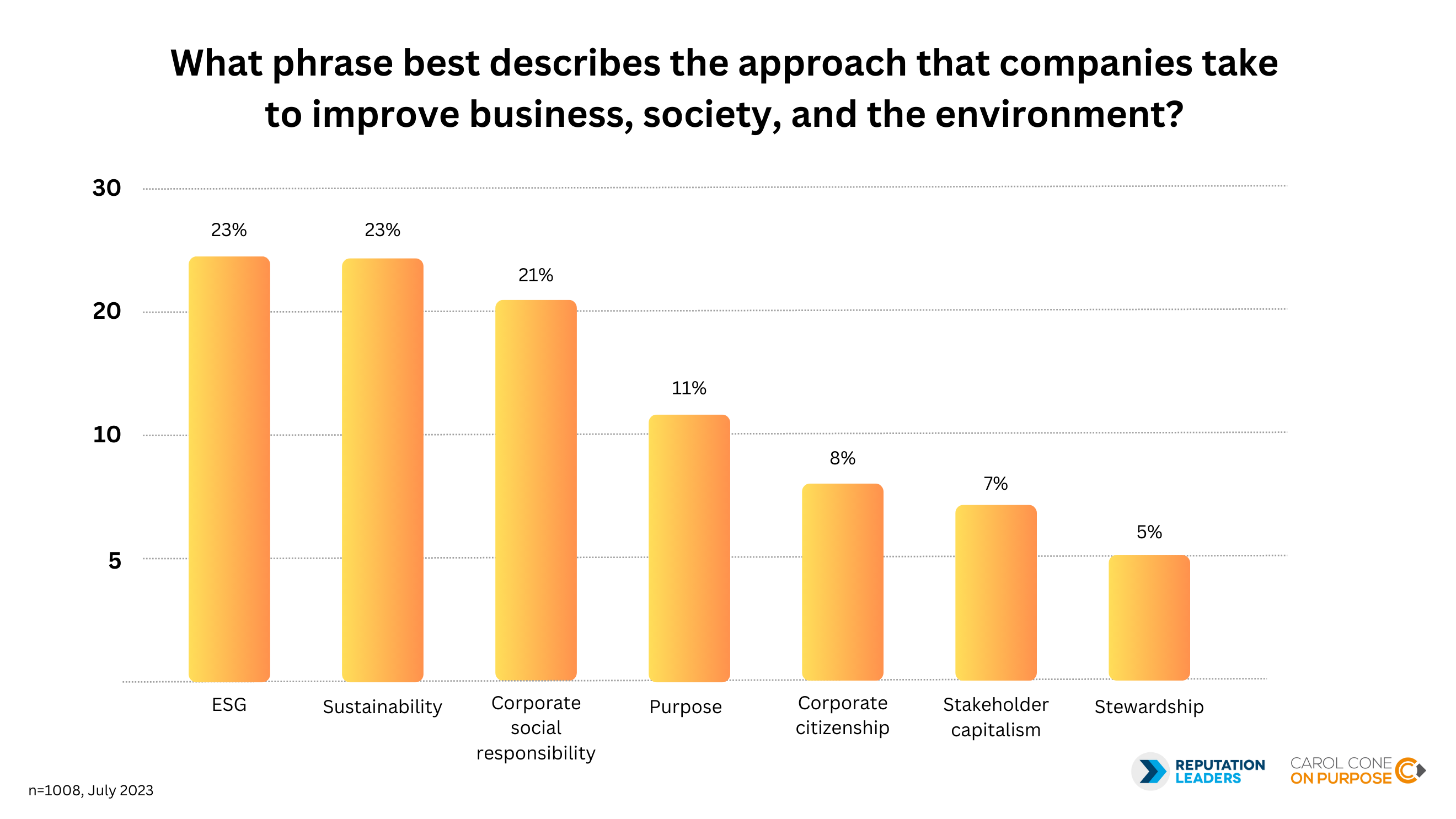
Across demographic groups, ESG and sustainability are the favored terms among men, while women prefer “corporate social responsibility,” a phrase that connotes a sense of obligation. ESG is also the top choice for younger audiences, particularly those aged 25 to 34, while consumers aged 55 to 64, prefer the term “sustainability.” There are regional differences, as well. People living in the Northeast prefer sustainability, while their Southern and Midwestern counterparts prefer ESG.
Reputation Leaders also analyzed the tone of media coverage related to Americans’ top three terms: ESG, CSR and sustainability. CSR garnered the largest share of positive sentiment at 37 percent, with sustainability in second place at 32 percent and ESG trailing at 20 percent. ESG was the only term to have a significant amount (10 percent) of negative sentiment.
What now?
This study can help support companies in exploring the terms they will use to discuss the impact their business has on society. It is important to develop a clear, shared perspective and take a long-term view.
From the United Nations to the World Economic Forum, global leaders are advocating for businesses to embed a net-positive approach into their operating models to accelerate innovation and impact. Increasingly, employees, customers, supply chain partners, and others are asking about the ESG commitments of the companies they work for or with. Business leaders need to have answers and a strong point of view on which issues are most important to their business, and why. Our best advice? Don’t worry about what you call it — stick to your organization’s long-term, strategic commitments to stakeholders, society and the environment.
When it comes to communications, here are three ways to help depolarize the conversation:
- Be clear about the goals of ESG. ESG is not about imposing a set of values on business. It provides a framework for companies to assess and optimize their value and impact.
- Increase transparency around ESG data and metrics. This will help to ensure that investors and other stakeholders are making informed decisions.
- Embrace standardized reporting frameworks. This will make it easier to compare companies' ESG performance — think: the Task Force on Climate-Related Financial Disclosures (TCFD), the Global Reporting Initiative (GRI) or the Sustainability Accounting Standards Board (SASB).
Yes, the polarization will continue, especially as the 2024 presidential election nears. As the world continues to endure climate impacts from extreme heat and flooding to record-breaking wildfires, there also will be greater demand for businesses to address environmental challenges.
Scores of studies suggest that ESG — done right — drives sustainable competitive advantage and can accelerate organizational growth over the long-term. An impressive 80 percent of investors believe that companies with strong ESG practices can generate higher returns and make for better long-term investments, according to research from Morgan Stanley.
By continuing to show a link between ESG issues and the business, we can help to make the debate around ESG more constructive and less polarizing. This will ultimately benefit businesses, investors and society as a whole.
Reputation Leaders is a global thought leadership consultancy. Our people are passionate about business as a force for good, believing that profit and purpose can co-exist by aligning brand purpose with responsibility towards the environment, society and corporate citizenship. Reputation Leaders Ltd managed the study which ran with 1,000 nationally representative respondents in the U.S. in July 2023.
The Purpose Collaborative is a global group of 45+ firms and subject matter experts in 20+ countries with 500+ professionals, all developing breakthrough work to help organizations accelerate their purpose, ESG, and sustainability commitments. Member capabilities include research and data analytics, employee engagement, sustainability strategy and reporting, digital marketing, creative programming and storytelling, and video production. Learn more here.
Image credit: blacksalmon/Adobe Stock
Showcasing Sustainable Solutions for Urban Life


(Image courtesy of Smart City Expo World Congress.)
We’ve lived in cities for at least 6,000 years, yet urban life wasn’t always the norm. One hundred years ago, only 20 percent of the global population lived in cities. Now, the majority of us live in cities, and that number is projected to increase to 68 percent by 2050.
But these metropolitan areas are far from perfect. Cities are a major contributor to climate change, emitting 70 percent of the world’s carbon dioxide. They’re also hotspots of poor air quality and water pollution, damaging residents and the environment.
Yet cities can also be part of the solution. By piloting clean energy, sustainable buildings and public transport, they can lower their footprints and improve the well-being of their citizens.
The Smart City Expo World Congress, which brings together industry executives, government officials, researchers and entrepreneurs, focuses on moving cities toward a better future. With over 25,000 attendees from over 850 cities, it’s an unparalleled networking and educational opportunity. By transforming cities into more sustainable and livable spaces, can we have our city life and embrace it, too?
Organized by Fira de Barcelona, the 2024 congress invited 600 speakers and experts under the theme “Live Better.” Held since 2011, this year was the biggest event ever, with over 1,100 exhibitors showcasing the latest solutions and technologies for urban efficiency, mobility and sustainability.
“Smart City Expo aims to establish a common strategy for urban innovation: to improve well-being, create opportunities, and foster a better relationship with our planet and our communities,” Ugo Valenti, Director of Smart City Expo World Congress, said in a statement. “If we want to live better, we need to change the way we live, leveraging technology, innovation and collaboration. We want to offer a meeting point where all those involved can come together and chart a roadmap towards a better tomorrow.”
The event focused on strategies to improve cities in areas like mobility, public services, utilities, citizen engagement and sustainability. For example, the biotech company Bioo displayed biological batteries fueled by soil microorganisms, the robotics company Clevon featured electric autonomous delivery robots, and the city of Bamberg presented a drone tree-monitoring project.
Besides showcasing the latest tech and innovations, the conference also walks the walk — focusing on minimizing waste, banning single-use plastic, and recycling and reusing any leftover conference materials. All structures from the conference were distributed to schools, museums and gardens after the event. And leftover food was donated to the NGO Nutrition Without Borders.

Tech-focused solutions
At this year’s expo, smart solutions abounded.
The Curiosity Lab in Georgia, for example, is developing smart traffic lights. These lights respond to real-time traffic conditions, reducing congestion and commute time. In turn, they lower vehicle idling and the associated greenhouse gas emissions. In the U.S., vehicle idling accounts for around 30 million tons of carbon dioxide annually. The lab also has a 500-acre tech park and innovation center for startups and companies to develop new technology like shared autonomous vehicles, health monitoring devices and virtual 3D models.
Similarly, Gogoro, a producer of electric scooters and battery platforms, is focused on improving traffic. It’s filled the city of Taipei with battery-swapping stations for electric scooters. Riders can drop off used batteries and get a new one immediately, fueling the transition away from gas and oil-fueled bikes. Electric scooters grew to 12 percent of all scooter sales in Taiwan in 2022. As a plus, the charging stations feed energy back to the grid in times of need.
Another attendee, the consultancy firm Ecoten Urban Comfort, created an urban heat vulnerability map of Vienna to help address extreme heat. This product combines heat exposure, existing green spaces, water bodies and the population density of those most vulnerable to extreme temperatures — such as children and the elderly. As a result, Vienna developed its Cool Streets project, creating open spaces with trees and installing mist showers to cool the pavement. For a few weeks, it also banned parking in certain areas so citizens could spend more time outdoors.
Large-scale solutions
Besides the barrage of new tech, other solutions were centered on the urban big picture.
The research firm ThoughtLab studied 250 cities, representing nine percent of the global population, and divided them into three categories — future-ready, progressing and beginning — based on self-reported survey data and monitoring data, including pollution and traffic levels from Numbeo. Future-ready cities, like Tokyo, Seattle and Quito, are sustainable, resilient, digitally enabled and inclusive.
Overall, future-ready cities have made substantially more progress in improving sustainability, transportation, safety and health compared to other cities. More than 80 percent of future-ready cities have made significant technological investments in monitoring air and water quality and energy usage. They’ve also set emissions targets and are working to improve infrastructure resiliency for natural disasters.
The firm’s report is meant to act as a guide and, ideally, inspiration for other cities in the progressing or beginning phases, said Daniel Miles, chief economist of ThoughtLab. Despite these positive examples, ThoughtLab found many cities still face daunting challenges, from climate change, public health and housing shortages to inadequate transportation and infrastructure.
In addition to urban research, other large-scale initiatives were focused squarely on climate change mitigation.
For instance, the European Union's mission for Climate-Neutral and Smart Cities aims to make over 100 cities emissions-free by 2030. Encompassing 12 percent of the European Union population, these cities are found in each member state. They first develop investment plans alongside an overall plan for climate neutrality across sectors, including energy, buildings, waste management and transport.
For instance, Lisbon plans to reduce its emissions by promoting electric vehicles and public transportation, reducing traffic in the city, and improving the energy efficiency of buildings. It also aims to increase solar and other renewable energy, install green roofs, plant trees and augment recycling.
“These cities are a model for other cities,” said Patrick Child, deputy director general for the environment at the European Commission. It’s planned that all European cities will follow suit by 2050.
But there are challenges along the climate-neutral path, including mobilizing funding, getting the legal framework right and obtaining buy-in from the citizens involved, Child said.
A better urban life
Cities cover only two to three percent of land worldwide, yet they use over 75 percent of our natural resources and energy. Sustainable development can align our needs with those of the planet. It can also fuel job growth, free up funds and improve living conditions. And sustainable cities may spur economic growth by attracting a more talented and diverse workforce, while also improving workers’ health and time efficiency.
By bringing together diverse people and companies, the Smart City Expo World Congress is spreading ideas and innovation. It’s an important step in our path to a smarter and greener city life.
Editor's Note: Travel and accommodations to Barcelona, Spain, were provided by the Smart City Expo World Congress. Neither the author nor TriplePundit were required to write about the experience.
Will the World Bank's New Policy Reduce the Environmental and Social Harms of Clean Energy?

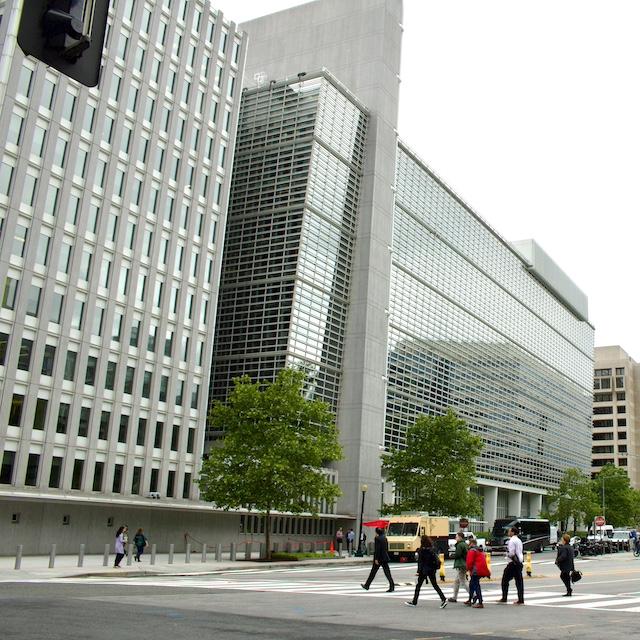
The World Bank Group's headquarters in Washington D.C. (Image: Zoshua Colah/Unsplash)
This article about the World Bank’s Approach to Responsible Exit policy is part of our series on responsible mining solutions. The push for clean energy is fueled by a growing demand for minerals, but conventional mining has a track record of harmful social and environmental impacts. Here is another potential solution to that problem.
The World Bank recently released its Approach to Responsible Exit, which includes five principles to ensure that risks to communities are managed responsibly when the development bank decides to exit a project investment.
The lending arm of the World Bank, the International Finance Corporation (IFC), was criticized in the past for leaving projects abruptly and putting communities in harm’s way.
Development finance institutions, like the World Bank, “have this development mandate to support countries to eliminate poverty, but in many cases, they act just like any other bank,” said Carla García Zendejas, director of the People, Land and Resources program at the Center for International Environmental Law.
Development banks engage in a wide range of infrastructure, energy, development and mining projects. Unfortunately, many communities are negatively impacted by those projects. Particularly with mining projects, large multinational companies take control of the land and may either directly, or consequentially, inflict serious environmental and social harm to the area.
This happens around the world, with or without the investment backing of development banks. At least when a development bank is involved in a project, there are established mechanisms where communities can make complaints and seek remediation.
When the bank leaves, so do those mechanisms. That’s when the responsible exit principles are supposed to come into play.
What are the responsible exit principles?
On October 4, the World Bank and IFC released their long-awaited responsible exit principles. They include things like addressing environmental and social issues, evaluating different impacts, and considering institutional constraints and precedential implications.
The document provides a brief explanation of each principle but does not go into explicit detail on what a satisfactory application would look like or the steps to achieve it. Having the principles in writing, however, is a good sign for communities.
“It’s taken thirty years for this,” Zendejas said. “It is significant that the IFC and the World Bank are putting this out because there was no policy before that said, ‘Wait, you should see if there are environmental or social issues before you leave a project.’”
Principle Two, for example, states that the IFC should, “Take into consideration whether IFC’s exit would increase or exacerbate existing significant environmental and social issues, and if so, evaluate options available, if any.”
Why are the principles needed?
“This is about finally addressing the harms, human rights violations and reprisals,” Zendejas said. “Unfortunately, bad projects on every continent have left communities in horrible situations.”
In a previous article, we highlighted a community in Colombia that was fighting to keep an IFC-funded mining project off their land. Other examples include schoolchildren abuse in Kenya, reprisals in Nicaragua and disregarding Indigenous rights in Panama.
The development of the principles is already affecting IFC-funded projects.
“In one of our cases in Panama, the new policy applied, and we have had more engagement with the IFC,” Zendejas said. “Before, they weren’t as open as they are now to hearing about how Indigenous communities are being ignored by the state of Panama and how their right to free, prior and informed consent still hasn’t happened.”
Will the new principles solve all problems?
It remains to be seen how the responsible exit principles will help communities affected by development projects funded by the IFC — projects that, by IFC mandate, are supposed to help those communities.
Along with the lack of clarity and definition around what each principle entails, there is a lack of transparency.
“Unfortunately, when the IFC actually uses these principles we won’t be able to read any document to see their reason for leaving or not leaving,” Zendejas said.
The lack of transparency could lead to a lack of accountability, and there is no defined process for what happens if the IFC does not follow its principles. But the organization-wide mandate itself should hold the bank accountable.
“The principles apply to everyone at the IFC. It’s not just the environment and social team, not just the responsibility of those who design or monitor — it’s everyone,” Zendejas said. “Ideally because it is everyone’s responsibility, we should be able to see in the future if it was done properly or not.”
What’s the next step for protecting affected communities?
There are development finance institutions all around the world. One of the hopes is that these responsible exit principles will encourage other regional development banks, like the Inter-American Development Bank and the European Bank for Reconstruction and Development, to develop and release similar policies.
The IFC is also developing a remediation framework, which will hopefully bring some clarity to the process of providing remedies to communities, and the exact role that the IFC and its client partners play in providing remedies.
“Clients of the IFC are not against providing remedy,” Zendejas said. “More than anything, they want to find out how it will be done, how the IFC is going to roll this out.”
There is no timeline for the remediation framework’s release.
Development banks need to follow their mandates
While the release of the responsible exit principles is an important step, there are still major frustrations from communities and the organizations that represent them about the unremedied, repeated harm communities continue to experience at the hands of IFC-funded projects.
“What is the point of having an environmental and social sustainability policy, Indigenous peoples’ rights that you say you’re going to respect, stakeholder engagement that you say you’re going to do, consultation that you say you’re going to ensure, if you don’t do it?” Zendejas said. “If that’s going to be the case, take away your label as a development institution meant to benefit those who are most in need. Just be a private bank and stop saying that you are something else.”
Aaron Pedrosa of the Philippine Movement for Climate Justice became emotional saying he feels like a fixture at the World Bank meetings in October while speaking alongside Zendejas. He is still fighting for justice for 19 communities in the Philippines that were harmed by IFC-funded coal projects. He presented the formal complaint seven years ago.
Perch Energy’s Community Solar Turns Renewable Cons Into Pros

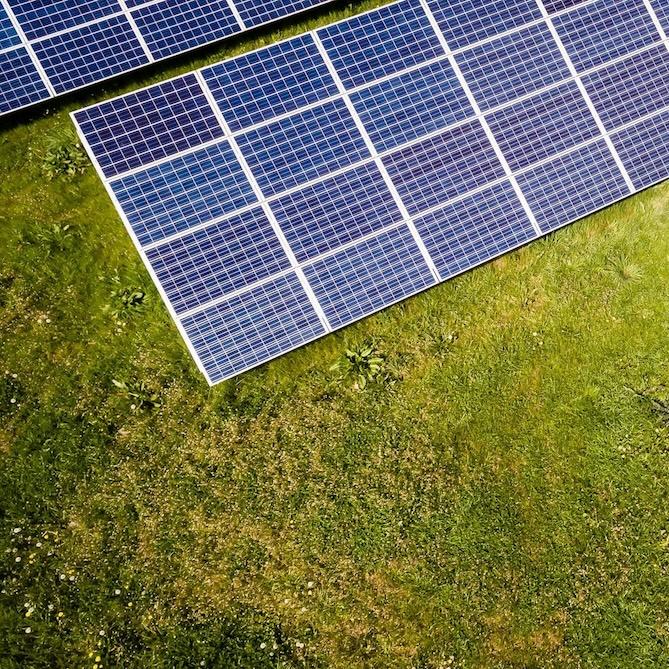
(Image: Andreas Gücklhorn/Unsplash)
“Whilst we didn’t turn the page on the fossil fuel era in Dubai, this outcome is the beginning of the end,” said U.N. Climate Change Executive Secretary Simon Stiell during his closing speech at last year's global climate talks (COP28). "Now all governments and businesses need to turn these pledges into real-economy outcomes, without delay.”
This month, all eyes are on the next stage of U.N. climate talks (COP29) and the fossil fuel transition agenda. And Stiell's call to action is not just for governments, but also for businesses to their double energy transition efforts.
Expanding the use of solar energy can make significant progress on the greenhouse gas reductions needed to slow climate change, but particularly at the residential level, the transition to solar presents a big issue of access. Some people may not be able to finance a switch to solar, and others may simply not have the space. Likewise many with the desire to be a part of the transition may live in a rented or leased property and thus lack the ownership or authority. Solar isn't a one size fits all solution. It has to fit — on your roof specifically. It also has to be facing the right direction for the system to generate enough power.
Perch Energy is aiming to remedy this access issue and expand the limits and application of renewable systems with its growing community solar network. “It's about building smaller format community solar farms, which usually produce about 5 megawatts of clean power from the sun.” Perch Energy CEO Bruce Stewart told 3p. “The idea is that you could sign up as a member of that community, and whatever your house or business needs, you receive that discount on your monthly bills.”
Community solar works just as it sounds: A small solar system is installed in a community, and neighbors and businesses can purchase shares of the power it generates so they can start using more renewable energy and lower their monthly bills. Perch's community solar farms could be anywhere from the side of a highway to the top of a building and are connected directly to the community’s power grid, Stewart said. Through this direct grid connection, the solar system supplies all the power acquired, and customers receive a discount on their bills based on their subscription. And it’s not just residential addresses that are eligible for subscription in this program. Anything from a restaurant to a hospital can sign on, and it’s currently available in 20 U.S. states.
Perch’s community solar stands out because of this widely applicable group model that brings the solution of solar into unlikely places like the densely populated city of New York. New York so far has a large market for this new service, with over 6.6 gigawatts of capacity that has already been built. States like Colorado are also seeing massive growth in the market, Stewart said, and projections mark the value of this industry to more than double over the next five years. What’s the secret to the growth of this new venture and its future projections? Well, it’s not a secret and it’s not just one.
Ironically, a community of stakeholders came together to make these projects possible. Most states have carbon reduction or net-zero items on their development agendas, so getting the legislation for shared renewables passed has been reasonably smooth. Although the need for renewable solutions has existed for some time, the barrier to access impedes the progress of this clean energy transition even for builders. To be more specific, many cities have the need for alternative clean energy, but the proper space to build and provide enough power to make a difference in the community often eludes companies and governments when tackled alone. It was concerted community efforts that brought Perch’s solar services much of the success it has managed so far.
Logistical issues like space plague some of the greener ambitions of cities across the U.S. At a certain point in the ideation process for community solar, stakeholders learned that it actually costs less material and funds to build a larger farm to service a large population as opposed to individual solar systems for individual households and businesses. This seed of breaking the door to access through the community took root and inspired other stakeholders. Power companies, for instance, offered to provide incentive for programs like these, which helped to ease the process for builders and those who maintain the farms, Stewart said. Perch Energy comes in as the manager of this customer relationship between the solar farms cooperative and the customers.
Perch's community solar model has also benefited New York renters living in affordable housing in Brooklyn, the Bronx and other boroughs. “Part of the community solar rules are geared toward creating incentives to help low- and medium-income customers. These folks who are low-income and renters probably won’t be able to put anything on their roof. So, we sought to deliver 20 percent savings to some of them. For people who live in that economic position, when the power bill is such a large part of the household budget, it’s really valuable,” Stewart said.
This affordable housing campaign in partnership with the investment company Nuveen aimed to enroll residents across New York. The program continues to provide these savings to low and middle income families. The benefits to community solar are abundant, and with a program like this even the most vulnerable in our societies can enjoy some. It can alleviate many logistics concerns and limitations in the construction industry and effectively make solar possible in areas where it was ruled out as impractical. It also has the potential to massively reduce the financial barrier to entry for the working american that may not necessarily be able to afford that initial hardware and installation fees. In short, community solar can turn many of the cons of solar energy into pros.
Shifting When and Where Electricity is Used Can Avoid Gigatons of Carbon Emissions
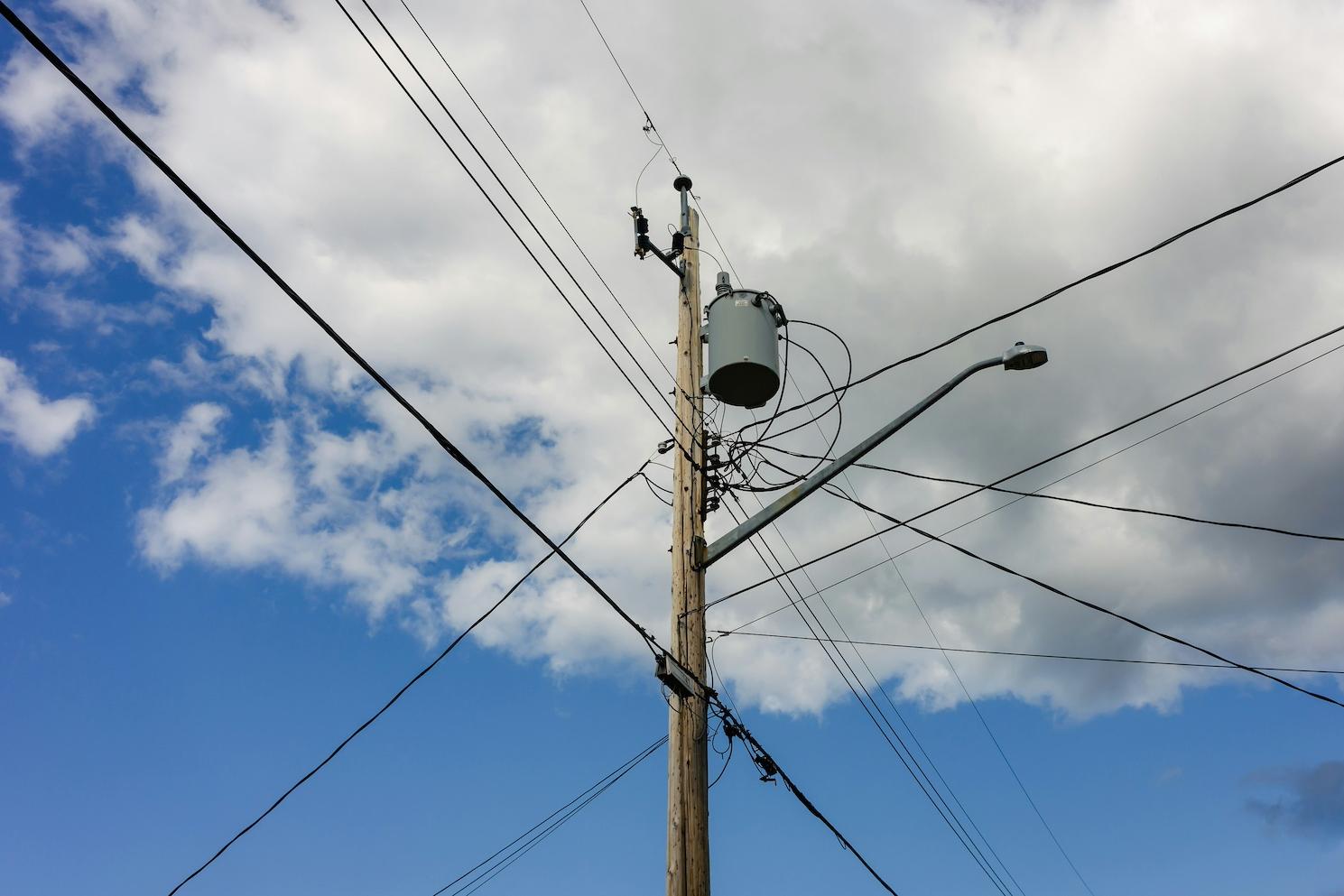

(Image: Greg Rosenke/Unsplash)
How electricity is produced and when it is used has a huge impact on how clean it is. As such, marginal emissions, which result from a power plant turning on or increasing its production to meet increased demand, represent substantial potential carbon reductions. A newly expanded dataset from the tech solution nonprofit WattTime suggests as much as 9 gigatons could be avoided per year.
The nonprofit works with major corporations like Microsoft, Toyota and Salesforce to shift when electricity is used and where it is purchased while optimizing grid decarbonization. Its new dataset shows the marginal emissions associated with almost 100 percent of global electricity consumption. It can be used to estimate emissions based on when and where electricity is used and emissions that will be avoided based on where renewable energy projects are located. With more of this data in one place than ever before, more corporate leaders, policymakers and consumers can make informed decisions to avoid the most emissions possible.
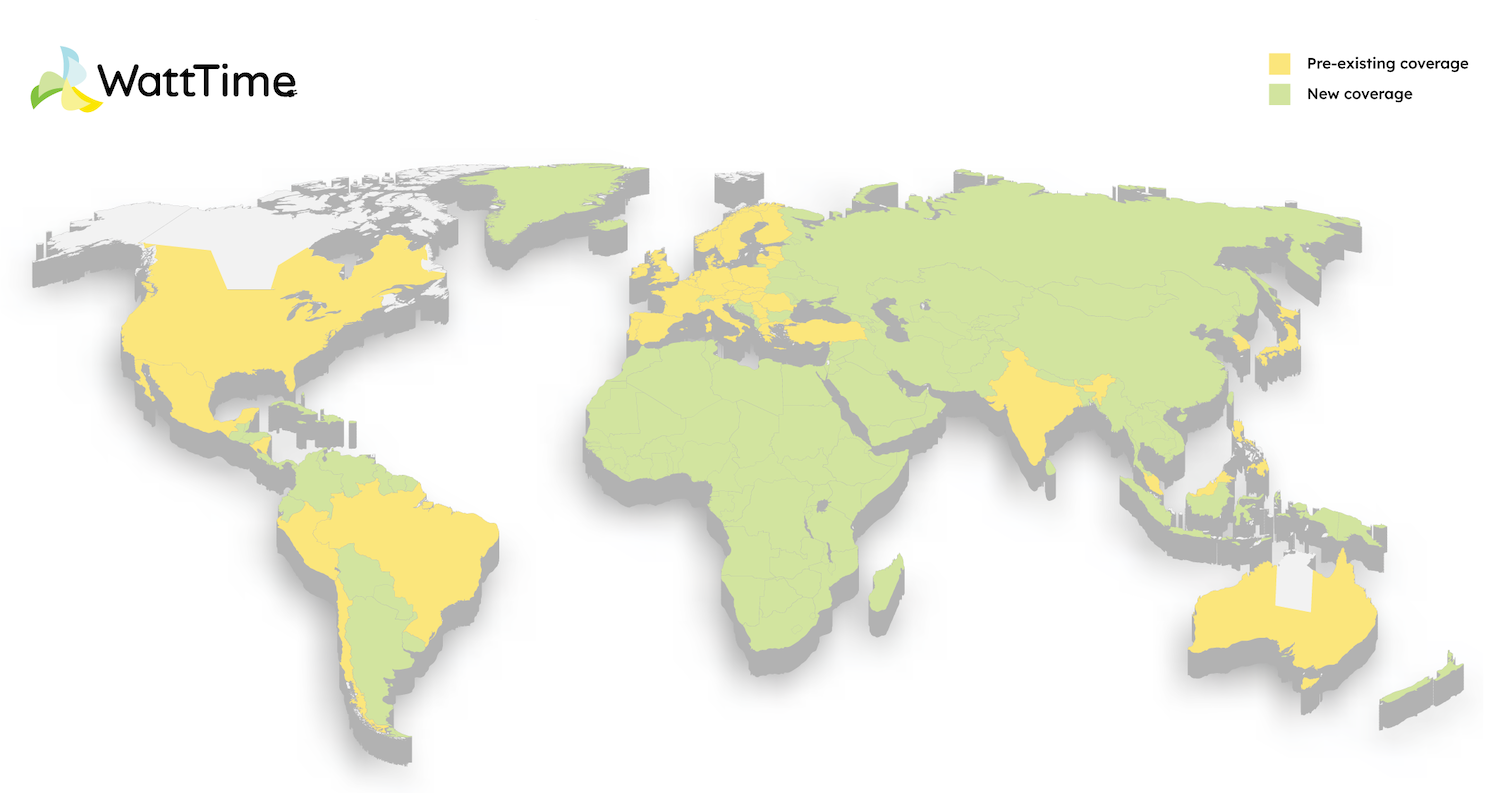
A simple strategy for lowering peak energy use
Energy is dirtier during peak times because electrical grids rely on peaker power plants to augment electricity generation when demand outstrips regular production, and peaker plants are often more polluting than other power plants due to less effective emissions control mechanisms. Marginal emissions in the United States went up over the prior ten years, which makes lowering energy usage integral to reducing overall carbon emissions, according to a 2022 study.
“If you, for example, have a Nest thermostat in the United States or you drive a Toyota electric vehicle or use a Windows machine, all those devices now use our data to — instead of just using electricity at any old time — look first at how clean or dirty electricity is right now and try to use it more when it will cause less harm to the environment,” Gavin McCormick, executive director and co-founder of WattTime, told TriplePundit. “That's about 900 million devices worldwide now that are automatically using energy at cleaner times.”
But that’s not to say personal devices are programmed to charge during non-peak hours. Rather, this strategy has to do with behind-the-scenes updates and calculations in data centers. “They're optimizing things that have no effect on the consumer,” McCormick said.
Rethinking where renewable energy is built
Unfortunately, the energy transition has been far from equitable. Not only are large parts of the globe left with minimal access to electricity, but emissions from electricity production can vary greatly by country and region. As a result, new renewable energy in areas that primarily rely on coal and other fossil fuels has a much bigger impact than it would in an area where the grid is already largely renewable.
“One of my favorite stats is a solar panel in India will replace three times more emissions than the exact same solar panel in California,” McCormick said. “So Amazon made a huge decision to build a large solar farm in India, where it will reduce a lot more emissions, instead of local on the West Coast.”
In areas like California, where renewable energy is already entrenched, adding more solar panels will just turn off existing ones because there aren’t any coal plants left to replace, he said. Under ideal conditions, California already has the infrastructure to meet most of its electricity needs with renewable energy. Adding more solar won’t eliminate the need filled by natural gas power plants after dark.
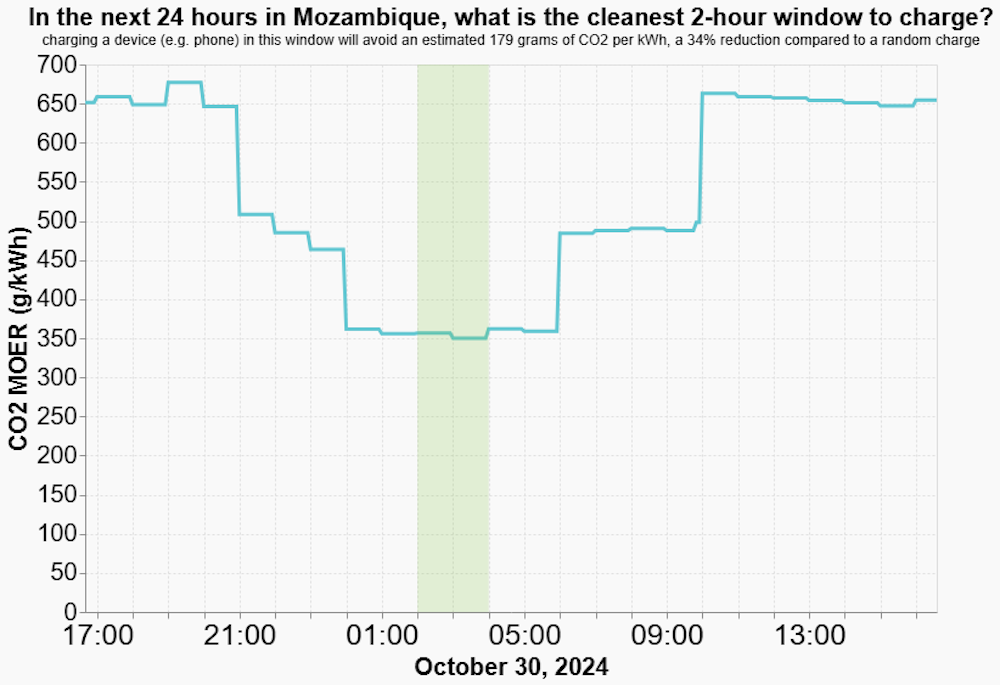
A lot of the companies that partner with WattTime are taking the same approach as Amazon, McCormick said. Another more complicated option for companies is a power purchasing agreement, which typically involves making a long-term commitment to buy renewable energy from a developer.
“A power purchasing agreement is increasingly how all these companies buy energy, so now, when you sign a contract for a power purchasing agreement, it's increasingly common that you don't have to sign it in your local area,” McCormick said. Instead, “You sign a contract where your two utilities will trade that information and those prices, so you're paying to build renewable energy somewhere else, but then it kind of pays off. That's not a carbon offset, that's an electricity contract. It's a really cool innovation.”
Maximum impacts versus likely impacts
WattTime’s 9 gigaton estimate of the amount of marginal emissions that could be averted each year represents the maximum possible impact. It would take 100 percent participation in optimizing energy use decisions to get there. The more likely number is 6 gigatons, but that’s still just an estimate, McCormick said.
It all depends on participation. That’s more difficult when it comes to building renewable energy in the most impactful locations, but easier for something like optimizing smart devices to use energy at cleaner times because it typically doesn’t have negative effects, McCormick said.
There are also some limitations to WattTime’s data from countries where marginal emissions aren’t tracked as precisely, but McCormick said he is confident that the estimates for those countries are accurate enough to determine which time periods in the region are cleaner or dirtier.
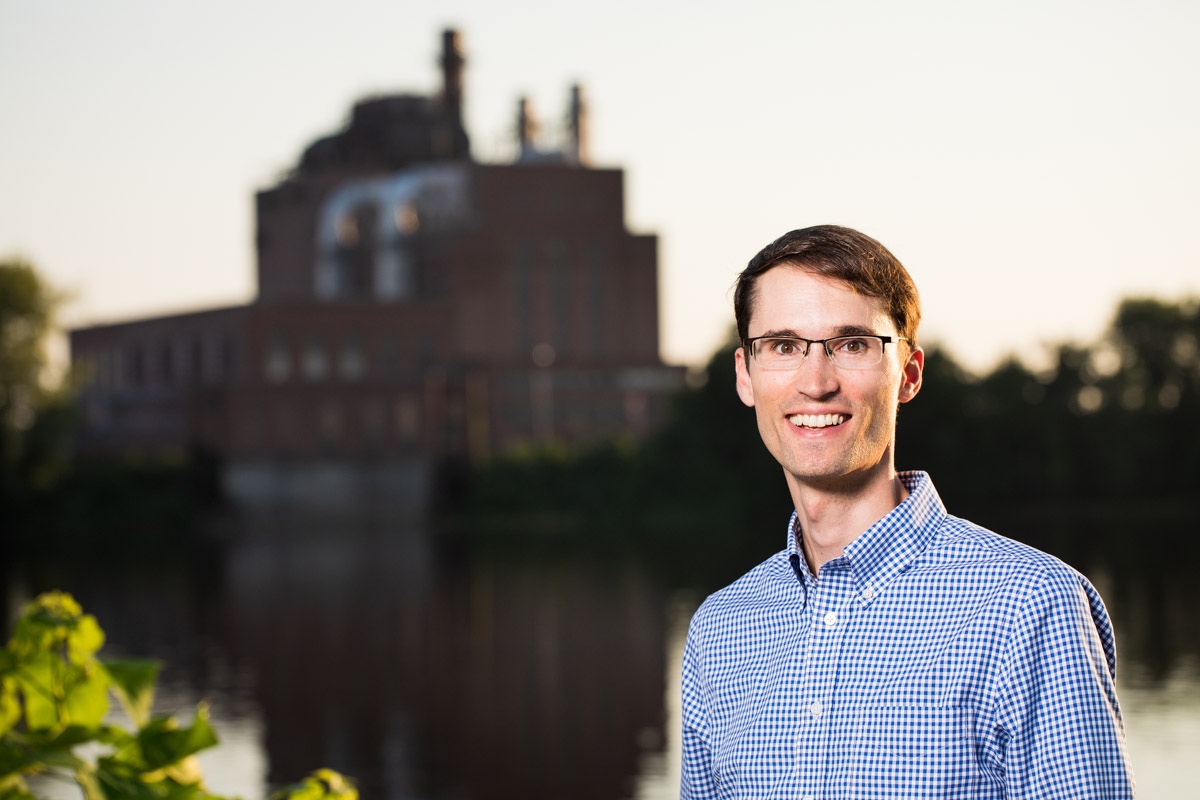
Decarbonization as social justice
“One thing I'm always struck by is the close connection between this marginal emissions data and social justice and environmental justice,” McCormick said. “You can drive more impact with renewable energy if there is pollution to get rid of in the first place.”
That means focusing on areas where there is less wealth and people haven’t been able to assert their rights. Doing so will result in a more equitable distribution of resources and have a much larger impact on the population’s health, McCormick said.
“What happens if you build renewable energy where we recommend?” He said. “It basically means stop building more renewable energy in the wealthiest communities in the world, where we've already gotten rid of pollution.”
This story was updated on November 23, 2024, to clarify an explanation of the impact of peaker power plants.
Tackling Potent Super Pollutants is the Bridge to a Cooler Future


(Image: Irakli Janiashvili/Unsplash)
Carbon dioxide is accumulating in the atmosphere at a faster rate than ever, rising more than 10 percent over the last two decades, according to new data from the World Meteorological Organization. And United Nations Secretary-General Antonio Guterres recently warned that the goal to limit the rise in global temperatures to 1.5 degrees Celsius to avoid the worst consequences of climate change “will soon be dead” without swift and dramatic emissions cuts.
One way for the world to avoid that fate, and get there faster, is by reducing the impact of super pollutants like methane, black carbon, and hydrofluourocarbons (HFCs), which cause over half of all global warming by trapping heat in the atmosphere. That’s the mission of the recently launched Global Heat Reduction Initiative.
The summer of 2024 was the warmest on record for the Northern hemisphere — again. Nine of the 10 hottest years have occurred in the last decade.
Tacking super pollutants can provide quick reductions in heat, complementing long-term carbon dioxide reduction strategies, Kiff Gallagher, executive director of the Global Heat Reduction Initiative, told TriplePundit.
Methane alone is responsible for about 30 percent of all warming since the Industrial Revolution, and super pollutants are many times more potent than carbon dioxide, he said. Methane is 150 times stronger in the first year it is emitted. Black carbon, also known as soot, is up to 52,000 times stronger.
The opportunity lies in the short life of these pollutants, Gallagher said. While carbon dioxide heats up the atmosphere for centuries, methane disappears within 12 years and black carbon within days. This means reducing them will yield bigger near-term results. Avoiding one tonne of black carbon emissions in 2024 is more than 8 times more powerful by 2030 than by avoiding 1000 tonnes of carbon dioxide, according to the initiative.
By reducing super pollutants alone, the world can avoid 0.6 degrees Celsius of warming by 2050, according to the U.N. Climate and Clean Air Coalition.
“Addressing these pollutants is crucial in the near-term to slow the rate of warming and prevent catastrophic impacts,” Gallagher said. “Conventional climate accounting does not give us the full picture. And without full situational awareness, it is difficult to identify the most effective actions needed to mitigate global warming, especially in the critical near-term before longer-term decarbonization strategies can take hold.”
The Global Heat Reduction Initiative approach
The Global Heat Reduction Initiative — which is run by the third-party standards, certification and verification leader SCS Global Services — wants to incentivize companies to reduce excess heat trapped in the atmosphere by decreasing super pollutants alongside longer-lived emissions like carbon dioxide. The intention is not to supplant current efforts to reduce carbon emissions from fossil fuels and other sources but rather to add an opportunity for companies, governments and organizations to take more near-term action to tackle global warming, Gallagher said.
“It's critical that we focus on mitigating these pollutants now because we're experiencing destruction now,” he said. “We're experiencing the effects of accelerated warming in the form of massive hurricanes, droughts, fires and heat waves.”
To do so, the initiative developed an accounting approach that assesses drivers of global warming over any period of time, not just the conventional approach of 100 years. A 100-year window often doesn’t accurately show the accelerative pace of climate change and the impacts of the things driving it — including the true impact of short-live climate pollutants because they can dissipate over just a few days or a few years.
Called the Radiative Forcing Protocol, it was created as a practical application of the newest findings from the Intergovernmental Panel on Climate Change and was in development for more than a decade. It was peer-reviewed by the Scientific Advisory Panel of the Climate and Clean Air Coalition.
“The Global Heat Reduction initiative is the only accounting approach I'm aware of that has been put forward to allow corporations to include all of the different drivers of climate change,” Drew Shindell, a member of the Global Heat Reduction Initiative's Technical Advisory Panel, said in a video. “Targeting of short-lived climate pollutants is an essential complement to long-term decarbonization, and this Radiative Forcing Protocol allows companies a ready method to quantify that.”
A registry for companies to earn Heat Reduction Credits
With the help of the new protocol, the Global Heat Reduction Initiative helps companies measure and understand their full climate impact through its climate footprint tool so they can identify targeted mitigation projects, including methane capture, black carbon reduction and other heat-reducing activities.
The organization also created the Global Heat Reduction Registry, which issues third-party verified “Heat Reduction Credits” for effective climate mitigation projects, particularly ones that reduce short-lived climate pollutants. It is currently accepting mitigation projects for independent verification. Projects might recover methane from landfill gas and the anaerobic digestion of manure to produce biogas.
Addressing the trust and transparency challenges in the carbon markets is a key priority, Gallagher said. To that end, the registry is providing traceability, third-party verification, and other safeguards to build confidence in the credibility of their climate accounting and mitigation approach.
“We saw a gap between current climate accounting and current climate science, and we're taking the latest science on heat reduction, or heat and pollution reduction projects, and applying it to this new accounting method,” Gallagher said. “These are projects that are specifically targeting the mitigation, reduction of or avoidance of these super pollutants.”
Health impacts and financial risk are among the drivers for action
Reducing emissions from super pollutants doesn’t just bring the world closer to its climate goals, it also impacts human health, with more than 1 in 5 deaths worldwide caused by fossil fuel air pollution. Improved health is among the co-benefits of mitigating the impact of super pollutants on communities, ecosystems and sustainable development. An increase in local monthly temperature by 1 degree Celsius eventually leads to about a ten-fold increase in displacement, according to a University of Oxford study.
“If we're able to reduce methane and black carbon and tropospheric ozone and low-level ozone and fluorinated gases, then we’ll not only bring temperatures down, but we’ll also slow the rate of warming. That will enable us to get past the threat of tipping points, and will actually make a difference right now,” Gallagher said. “In our climate markets today, you have a long-term model based on 100 years, but we don't have 100 years. What we need is a complementary set of measurement tools that allows us to target these near-term, far more potent pollutants during this critical next 25 years.”
Among the drivers for more rapid business action on climate mitigation is risk.
“Companies are experiencing it now,” Gallagher said. “There's facility risk. They're unable to get insurance. And there's risk to their workforce. There's risk within their supply chains. So the problem is: You've got a risk, but you can't manage what you don't measure.”
Investors also increasingly see climate risk as a business risk, with the U.S. Securities and Exchange Commission adopting new rules for disclosing climate-related risks that are likely to have a material impact on a company’s business strategy, results of operations or financial condition.
For the first time, businesses, governments and investors can make verified claims not only about their carbon dioxide reduction, Gallagher said. But also the degree to which they are helping to draw down atmospheric heat.
Saved by the Supply Chain: How Offshore Wind Stakeholders Hope to Survive and Thrive


(Image: Enrique/Pexels)
Election Day 2024 sparked many conversations about the future pace of the energy transition in the United States. The offshore wind industry appears to be especially vulnerable to a change in federal energy policy, having been a frequent target of criticism by President-elect Donald Trump over the years. Nevertheless, offshore wind stakeholders are in a much better position to engage bipartisan support than just a few years ago.
The supply chain is deeper than ever before
The main difference between then and now is the supply chain. Offshore wind is a new industry in the U.S. When developers first began proposing offshore wind farms in the early 2000s, the domestic supply chain was still in a skeletal state. They relied on components and supplies from overseas, where the industry was maturing more rapidly.
In Europe, for example, offshore demonstration projects began appearing in the 1990s. The European supply chain was ready for commercial scale up by 2000 when the United Kingdom’s Crown Estate began leasing offshore areas for development.
In contrast, the U.S. did not get its first commercial offshore wind farm until 2016, when a 30-megawatt array of five turbines went into operation off the coast of Rhode Island. In the following years, activity practically ground to a halt, except for two additional turbines. Totaling 12 megawatts, they began operating off the coast of Virginia in 2020.
That was the extent of offshore activity in the U.S. until the Biden-Harris administration took office in 2021 and established a goal of reaching 30 gigawatts by 2030. So far, 10 commercial-scale projects are completed or in the pipeline. The massive, 2.4-gigawatt SouthCoast Wind project in Massachusetts reached an important environmental review milestone recently, bringing the total to 11. And federal offshore lease activity, which was formerly limited to the mid- and north-Atlantic coasts, spread to the Gulf of Mexico and the Pacific coast. Together, all of this activity spurs demand for domestic components.
The trade organization Oceantic Network counts 39 states hosting supply chain activities for the domestic offshore wind industry. That is important because it expands the field of offshore wind stakeholders far beyond coastal states.
The supply chain reaches across partisan boundaries, too. The Republican-led state of Texas, for example, is home to the leading firm Kiewit Offshore Services, which built the first-ever offshore wind substation in the U.S. Kiewit completed the substation last year at its facility in Texas. It was then transported to New York, where the developers Ørsted and Eversource are working on a 132-megawatt wind farm to serve Long Island.
Room for growth in the offshore wind supply chain
Despite the increase in activity, offshore industry analysts say the domestic supply chain is still not strong enough to support the 30-gigawatt goal by 2030. They also note that overseas suppliers cannot fill the gap in time. Still, offshore wind capacity in the U.S. can continue to grow if the domestic supply chain continues to grow with it.
The National Renewable Energy Laboratory analyzed the state of the U.S. supply chain in 2022 and made the case for stepping up supply chain investments. It concluded that coastal and non-coastal states will realize workforce and economic benefits from investments that leverage existing manufacturing resources. That includes ship-building facilities for the specialized vessels equipped to install offshore wind turbines.
“A domestic supply chain could create 10,000 full-time-equivalent jobs in major-component manufacturing facilities by 2030, with up to five times as many opportunities for supplier jobs, all of which would span the country,” according to the lab.
In a follow-up report last year, the lab indicated that the domestic supply chain will continue to grow long after the 30-gigawatt goal is met. One major contributing factor is new floating wind turbine technology, which allows wind farms to be located in water too deep for the conventional construction methods that dominate the wind industry today.
“A massive 2.8 terawatts of U.S. offshore wind energy potential — enough to power 350 million homes — blows over ocean waters too deep for wind turbines to be fixed to the sea floor with foundations,” according to the lab. One terawatt is equivalent to 1,000 gigawatts.
Bipartisan support for offshore wind
In a public statement celebrating the SouthCoast Wind milestone, Oceantic Network CEO Liz Burdock took note of another circumstance supporting a healthy future for the U.S. wind industry.
“This massive project, first leased during the first Trump administration, will create thousands of jobs and drive hundreds of millions into the national economy through investments in manufacturing and New England port facilities,” Burdock said, drawing attention to support for the offshore wind industry during Trump’s term as President from 2017 to 2021.
The timing of the SouthCoast lease is significant because the U.S. had no dedicated offshore lease process in the early 2000s. The ill-fated Cape Wind project, for example, was initially approved by the U.S. Army Corps of Engineers in 2004.
During the Obama administration, responsibility for leasing offshore areas in federal waters was transferred to the Department of the Interior, where the Bureau of Ocean Energy Management (BOEM) worked on refining the lease process. Though not entirely immune to lawsuits, the new process is a de-risking tool that provides developers with a predictable regulatory environment. As Burdock pointed out, the bureau continued to issue leases under the Trump administration.
“We applaud BOEM’s consistent and thorough regulatory process, which is attracting new investments in our 39-state supply chain and is enabling significant economic progress across our nation,” Burdock said.
It remains to be seen whether the bureau will be allowed to continue along its consistent and thorough track. But last spring U.S. Secretary of the Interior Deb Haaland outlined a five-year schedule for up to 12 new lease sales through 2028. If the plan fails to materialize, offshore stakeholders in coastal states won’t be the only ones to suffer the disappointment of lost opportunity.